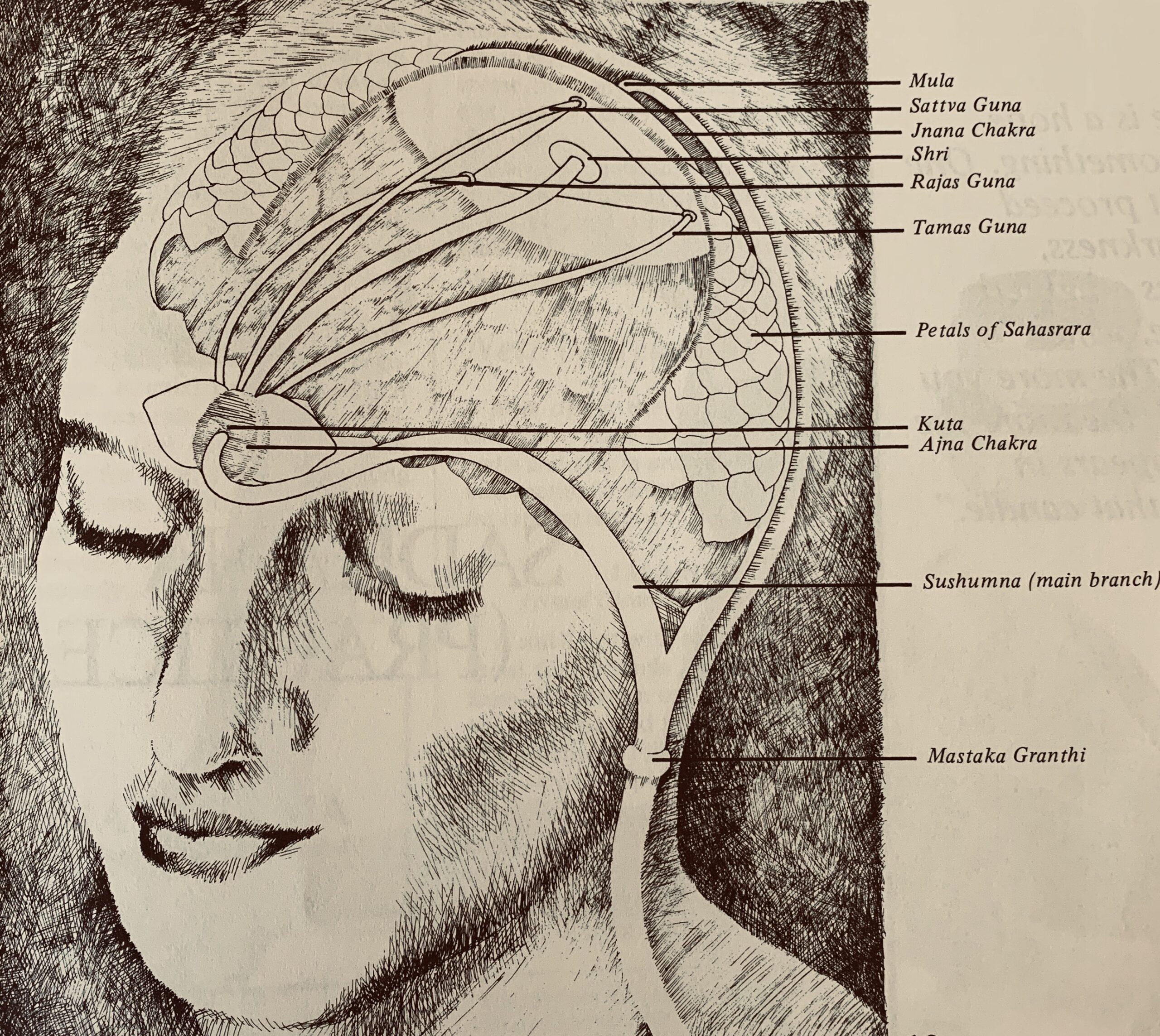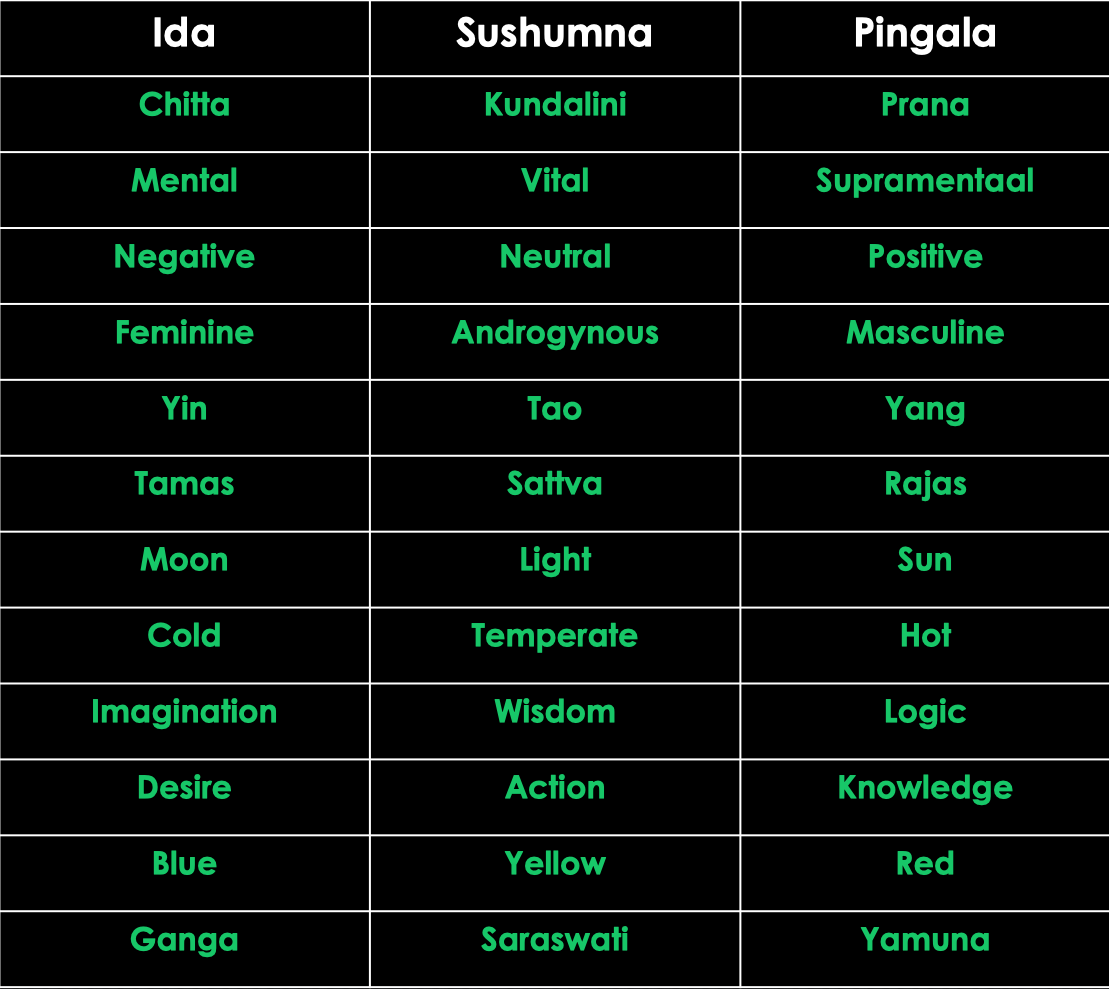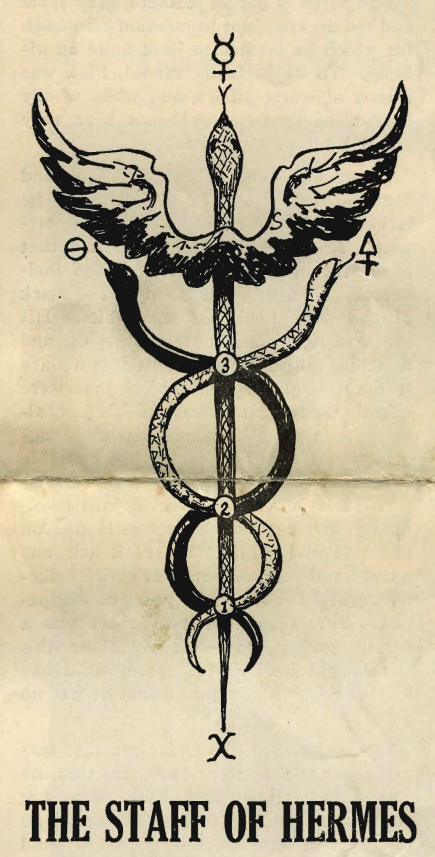Search your article
Nadis
Nadi
Nāḍī (Sanskrit: नाडी, lit. ‘tube, pipe, nerve, blood vessel, pulse’) is a term for the channels through which, in traditional Indian medicine and spiritual knowledge, the energies such as prana of the physical body, the subtle body and the causal body are said to flow. Within this philosophical framework, the nadis are said to connect at special points of intensity, the chakras.[1] The three principal nadis run from the base of the spine to the head, and are the ida on the left, the sushumna in the centre, and the pingala on the right.
The nadis play key role in yoga, as many yogic practices, including shatkarmas, mudras and pranayama, are intended to open and unblock the nadis. The ultimate aim of some yogic practises are to direct prana into the sushumna nadi specifically, enabling kundalini to rise, and thus bring about moksha, or liberation.
Nadi is an important concept in Hindu philosophy, mentioned and described in the sources, some as much as 3,000 years old. The number of nadis of the human body is claimed to be up to hundreds-of-thousands and even millions. The Shiva Samhita treatise on yoga states, for example, that out of 350,000 nadis 14 are particularly important, and among them, the three just mentioned are the three most vital.[1] The three principal nadis are ida, pingala, and sushumna.[2] Ida (इडा, iḍā “comfort”) lies to the left of the spine, whereas pingala (पिङ्गल, piṅgala “orange”, “tawny”, “golden”, “solar”) is to the right side of the spine, mirroring the ida. Sushumna (सुषुम्णा, suṣumṇā “very gracious”, “kind”) runs along the spinal cord in the center, through the seven chakras. When the channels are unblocked by the action of yoga, the energy of kundalini uncoils and rises up the sushumna from the base of the spine.[2]
Location of the nadis
The system of kundalini yoga describes Mooladhara chakra as the main plexus of the pranic body from which the nadis emanate. Ida, pingala and sushumna originate here and then Ida and Pingala flow alternately, coiling around the spinal passage from left to right, while Sushumna flows straight up through the middle. Ida emerges from the left of Mooladhara, Pingala from the right, and Sushumna flows straight up through the center. From Mooladhara chakra, Pingala curves to the right and crosses Swadhisthana, goes to the left to Manipura, then to the right to Anahata, to the left to vishuddhi, to the right to ajna at the top of the spine and then straight to Sahasrara. Ida follows a similar path, but on the opposite side. As Pingala crosses to the right, Ida crosses to the left and so on (see diagram). As ida and pingala cross over at each chakra, their energy currents branch off via the network of nadis to all the respective organs and parts of the body. In this way, the matrix of nadis carries these two opposite forces to every cell, organ, and part of the body [3].
Ida governs the left side of the body and pingala the right. This can be explained with the analogy of a magnet. If a magnet is cut in half, either end of the magnet assumes opposite polarity. Similarly, the body is polarized, so that pingala governs the right side and ida the left. The central axis of ida and pingala is sushumna. This nadi is the mystical path of yoga that flows in between ida and pingala. Sushumna rises straight up through the centre of the spine, meeting ida and pingala at the points where they cross the chakras, and uniting with them at Ajna chakra. Sushumna is the pathway through which the kundalini rises, and thus forms the basis for the progressive awakening of higher knowledge. However, this pathway remains dormant in most people until a higher state of evolution is reached. The inner structure of sushumna comprises three subtler nadis, which become active when sushumna is awakened. Inside Sushumna is vajra nadi, within which lies Chitra or chitrini nadi, and at the center is Brahma nadi, the subtlest flow. Brahma nadi is so called because the higher centers of consciousness are directly activated via this channel. When the kundalini shakti passes through this channel, transcendental experiences take place [3].
The locations of some the other major nadis are as follows:
1. Gandhari flows from the corner of the left eye to the left big toe. It is situated on the side of ida and supports it. Gandhari can be stimulated by baddha padmasana.
2. Hastijihva flows from the right eye to the left big toe and carries energy to and from the lower part of the body. Hastijihva and gandhari support ida and together form the left channel.
3. Yashaswini flows from the right big toe to the left ear and supports pingala.
4. Pusha flows from the left big toe to the right ear. Pusha and yashaswini support pingala and together form the right channel.
5. Alambusha begins in the anus and terminates in the mouth.
6. Kuhu begins in the throat and terminates in the genitals. Seminal essence is transformed to soma by this nadi. Kuhu is awakened by the practice of vajroli.
7. Shankhini begins at the throat and terminates in the anus. It flows on the left side of sushumna between saraswati and gandhari. Shankhini is activated by the practice of basti (yogic enema).
8. Saraswati is the nadi situated on the tongue. Those who possess gifted speech have an awakened saraswati.
9. Payaswini flows on the right side between pusha and saraswati, and is complementary to pingala. Its termination point is the right ear. The sect of ascetics called Kanphata Yogis awaken this nadi by wearing large earrings.
10. Varuni purifies toxins in the lower pelvic area along with kuhu. It terminates at the anus and is activated by basti and other kriyas.
11. Vishwodari resides in the area of the navel and flows between kuhu and hastijihva. It is related to the adrenal gland and the pancreas, and is activated by nauli kriya and uddiyana bandha. It improves the flow of prana throughout the body, and helps in the rising of prana along sushumna.
Polarity principle of ida-pingala
The entire universe is comprised of two forces, consciousness, and energy, which are interdependent and opposite, yet complementary. The universe hangs as a kind of web of interacting energies, suspended and functioning within the framework of tensions developed by this fundamental polarity. Wherever one looks, within nature, within the body and within the mind, this polarity can be seen as light and dark, positive and negative, male and female, and so on. At every level, these two great principles or forces are at work, creating and motivating the universe. When this cosmic polarity of prana and consciousness manifests in the microcosmic unit of the human body, it takes the form of chitta shakti and prana shakti, which correspond to ida nadi and pingala nadi. These two mental and physical channels within the body apply to all levels of being from gross to subtle, forming the basis for every perception, activity, and experience. They represent the two distinct forces within the human environment – the ebb and flow of human existence. Pingala represents the positive polarity and is the solar force. Physical vitality, dynamic activity and tension are qualities of pingala energy. It is hot in nature and corresponds to the sympathetic nervous system. Ida represents the negative polarity and is the lunar force. It is cold in nature and corresponds to the parasympathetic nervous system. Relaxation, passivity and sedentary activity are qualities of ida. The two mantras comprising the word ‘hatha’ correspond to the ida and pingala nadis. Ham relates to pingala nadi and tham or ksham to ida nadi. This symbology is also seen on the two petals of Ajna chakra. Pingala, the extroverting force, generally predominates during the daylight hours, especially in periods of physical and mental exertion, and activities requiring external interaction and attention. Ida also flows at such times, but it is subordinate to the pingala flow. In order to maintain a balance, ida generally predominates at night, counteracting the predominant flow of pingala during the day. Ida, the introverting force, is active while relaxing, reading, thinking, or sleeping [3].
Ida and pingala function according to a natural cycle, but on account of poor eating habits and inharmonious lifestyles, the natural cycle is often disturbed. Sometimes one nadi predominates and the other is suppressed. This leads to mental and physical imbalances and generally results in disease. Therefore, ida and pingala must be disciplined or made to function according to the laws of nature. Only when there is harmony between these two nadis can sushumna be awakened.
So, through the practices of hatha yoga, pranayama and raja yoga , the nadis should be purified and disciplined. The best practice for this is actually nadi shodhana pranayama – nadi purifying pranayama.
Link with flow of nostrils
Ida and pingala dominance is directly related to the flow of breath in the nostrils. If one checks the flow of breath at any moment, one will usually find that one nostril is more open than the other. When the flow of breath is stronger in the left nostril, it indicates that ida is dominant; when the flow is stronger in the right nostril it indicates that pingala is dominant. When one is sleepy or drowsy, one will notice that the left nostril is flowing. When one is physically active, the right nostril begins to flow predominantly. Observing this phenomenon, the yogis devised breathing techniques to regulate the flows of ida and pingala (and consequently sushumna) in order to intensify the experience of the pranic body.
Link with right and left brain
The specific functions of the brain also correlate with the activities of ida and pingala. The cerebrum is symmetrical, consisting of right and left hemispheres. The right hemisphere governs the left side of the body and the left hemisphere governs the right side of the body. Ida is connected to the right hemisphere and pingala to the left. The right hemisphere processes information in a diffuse and holistic manner. It controls orientation in space and is particularly sensitive to the vibrational realm of existence and those experiences which are intangible to the external senses. Thus it stimulates creative, artistic and musical abilities and is responsible for mental, psychic and extrasensory perception. Conversely, the left hemisphere which relates to pingala processes information in a sequential, linear and logical manner, and is responsible for rational, analytical and mathematical ability. In this way the nadis and brain hemispheres determine and motivate one’s responses in day-to-day life.
Link with koshas
The ida force is the subtle energy that controls the manomaya and vijnanamaya koshas, whereas pingala controls the annamaya and anandamaya koshas. In pranamaya kosha, the ida and pingala forces reach out in both directions. The thoughts and mental experiences that remain confined to manomaya kosha, or the mental dimension, are known as ida activity until they become physical. Desires, thoughts, emotions and feelings are given form and direction by the force of ida. Vijnanamaya kosha, the body of psychic and intuitive knowledge that one gains through sadhana, is also an aspect of ida, the mental force. Extrasensory powers, such as clairaudience and clairvoyance or telepathy, are developed within the range of ida. The range of pingala, the vital force, is experienced as physical vitality in annamaya kosha. In anandamaya kosha, the awareness which remains even in the deepest state of meditation, after the dissolution of all the samskaras and karmas, is the result of an awakened pingala. The awareness in samadhi is pingala energy; this is the subdest aspect of prana.
Sushumna
The neutral channel When the two forces of ida and pingala are balanced, the third channel of sushumna becomes active. It is a fact that when two opposing forces are equal and balanced, a third force arises. By striking a match against a corrosive surface, fire is created. By bringing positive and negative currents together, machinery can be operated. Similarly, when the body and mind are united, a third force arises. This force is called sushumna, the spiritual energy. The working of these three forces can also be understood through the analogy of an electromagnetic circuit with the north pole being ajna and the south pole mooladhara. Ida is the negative charge, pingala the positive charge, and sushumna the neutral. At each node of ida and pingala there is a concentration of energy, which forms pulsating patterns in the horizontal plane. These nodes are the chakras, force fields that expand and contract, depending on physical and mental activities. When there is an intensity of energy between ida and pingala, the chakras manifest in the form of light and sound. This manifestation occurs to a minor extent in normal breathing, but much more during pranayama practices such as nadi shodhana, and meditation. While ida and pingala conduct mental and physical energy, sushumna conducts a higher form of cosmic energy. The pranic and mental energies are finite, whereas the energy of sushumna is infinite.
When sushumna is active, the breath flows through both nostrils simultaneously. Normally this happens only for a few minutes when the breath dominance changes over from one nostril to the other, which usually takes place every ninety minutes. Sushumna flows after practising pranayama, prayer and meditation, and also when one is about to commit a criminal act. When sushumna flows, the whole brain operates, but only half of the brain is active during the flow of ida or pingala. At the time of sushumna, both karmendriyas and jnanendriyas, physical organs and mental organs, function simultaneously and one becomes very powerful. Feelings of equanimity and steadiness arise, because sushumna is the conductor of mahaprana, the kundalini energy. Meditative states dawn spontaneously, even in the middle of a traffic jam. The flow of sushumna is considered to be the most favourable for any type of sadhana [3].
Sushumna represents the integration and harmony of opposites at all levels. It indicates the balance and fusion of the opposite principles of ida and pingala. The following chart shows the experience of these three forces at various levels:
The Staff of Hermes
The most celebrated of all the Hermetic symbols is the serpent-wound staff. Though we see’ it today on the radiators of doctors’ motor cars and it is generally accepted as the emblem of science and philosophy, this winged rod has preserved its secret inviolate for unknown centuries. Consider carefully the accompanying diagram. Note that the conventional knob on the upper end of the rod has been returned to its original form-a serpent’s head. Therefore, the central staff with its wings becomes a flying serpent, or as it was called by the ancients, “a seraph,” one of the oldest known symbols of the Savior. Around this central serpent are twisted two other snakes, one white and the other black. The’ central winged snake represents the spinal canal fire, while the length of the Caduceus staff signifies the sixth ventricle, a tiny tube running through the spinal cord itself. The white and black serpents signify the two accompanying canals, also technically within the spinal column. These are called respectively the “Ida” and “Pingali” in esoteric philosophy, while the central canal is referred to as the “Sushumna.” The “Ida” is the vehicle of the energies of the moon, or the Great Mother, and the’ “Pingala” carries the energies of the sun, the Great Father. Therefore, the positive and negative principle’s-or the sharp and the flat of Fa, which is the musical note of the central canal-are symbolized by black and white snakes. The heads of the three snakes represent the’ three persons of the Trinity. The central head represents the Eternal, Indestructible One which stands unmoved in the midst of all things. This One’ is the Eternal Hermaphrodite. It dwells in the midst of darkness. This unmanifest One, winged and transcendent, comes into expression through the two. The Divine Unity is broken up. The white serpent becomes Henn and the black serpent Aphrodite. Henn means “fire” and Aphrodite, “water“. Henn is the spirit of the sun, the divine Yang of China. Aphrodite is the moon, the divine Ying of China. The Ying and the Yang are twisted around the central staff of the imperishable One and thus the equilibrium of the universe is established.
In the creation the universe descends as three substances through four elements, thus establishing the divine seven. The three substances are the central snake, Mercury; the white snake, Sulphur; and the black snake, Salt. ‘ In the human body, the elements descending from the brain are the head, air; the heart, fire; the solar plexus, water; and the generative system, earth. There is a fifth element called Akaaa, or the Divine Fire’, which is the fifth head of Brahma, the Hindoo Creator which was cut off by Shiva-the material nature-thus signifying that man’s spiritual perceptions were destroyed when his objective senses were’ unfolded. The two serpents-the one black and the other white-have their heads in the world of reality, but their bodies stretch downward into the’ snare of illusion-the lower worlds. According to the Mysteries, the physical world is established as the result of a spark flying back and forth between the tips of the two tails of the black and white snakes.[4]



